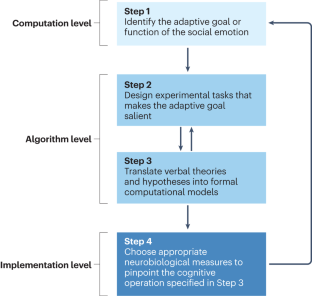A levels-of-analysis framework for studying social emotions
IF 16.8
Q1 PSYCHOLOGY, MULTIDISCIPLINARY
引用次数: 0
Abstract
Social emotions such as guilt and gratitude serve adaptive functions critical to social interactions and relationships. Therefore, an ecologically valid approach to studying the psychological and neural mechanisms of social emotions is to elicit and measure them in social interactive contexts, where relevant adaptive goals and functions are salient. However, multiple psychological and neurocognitive processes might be simultaneously activated during real-time social interactions: traditional observation-based tasks and self-report measures alone are not sufficient to capture and dissociate these processes. In this Perspective, we draw on Marr’s levels-of-analysis framework to argue that a holistic consideration of the goals and functions of a social emotion (computation level), formal modelling of its underlying cognitive operations (algorithm level), and neuroscientific measures of the biological bases of these cognitive operations (implementation level) will afford the theoretical frameworks and methodological tools necessary to advance understanding of social emotions. To support this argument, we describe research that showcases the utility of creative combinations of interactive tasks, neural and behavioural measures, and computational modelling for advancing understanding of how social emotions arise and achieve their adaptive goals and functions. Social emotions such as guilt and gratitude serve adaptive functions critical to social interactions and relationships. In this Perspective, Yu and colleagues argue that to advance a mechanistic understanding of social emotions, an integrative approach is needed that considers goals and functions, cognitive operations and biological implementation.


研究社会情绪的分析层次框架
内疚和感激等社会情绪具有对社会互动和人际关系至关重要的适应功能。因此,研究社会情绪的心理和神经机制的生态学有效方法是在社会互动情境中诱发和测量社会情绪,因为在这种情境中,相关的适应目标和功能非常突出。然而,在实时的社会互动过程中,多种心理和神经认知过程可能会同时被激活:仅靠传统的基于观察的任务和自我报告测量不足以捕捉和区分这些过程。在本《视角》中,我们借鉴了马尔的分析层次框架(level-of-analysis framework),认为对社会情绪的目标和功能(计算层次)、其基本认知操作的形式建模(算法层次)以及对这些认知操作的生物学基础的神经科学测量(执行层次)进行整体考虑,将为推进对社会情绪的理解提供必要的理论框架和方法工具。为了支持这一论点,我们介绍了一些研究,这些研究展示了互动任务、神经和行为测量以及计算建模的创造性组合在促进理解社会情绪如何产生并实现其适应目标和功能方面的实用性。
本文章由计算机程序翻译,如有差异,请以英文原文为准。
求助全文
约1分钟内获得全文
求助全文

 求助内容:
求助内容: 应助结果提醒方式:
应助结果提醒方式:


